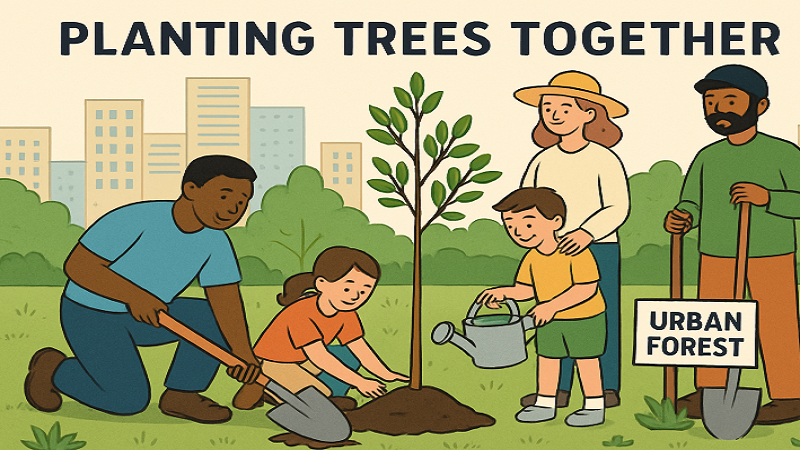Key Takeaways
- Community involvement is crucial for the success of urban forestry initiatives.
- Integrating technology can enhance the monitoring and management of urban trees.
- Educational programs and public engagement foster a deeper connection between residents and urban forests.
Urban forests are more than just patches of greenery—they are essential lifelines for city dwellers, helping to mitigate air pollution, reduce heat, and provide critical habitats for wildlife. However, the challenges of population growth, climate change, and limited green space demand fresh, innovative solutions. Ensuring healthy and resilient city trees requires both creativity and collaboration. Working with tree care professionals can maximize the benefits of these natural assets—learn more at Tree Work Now, a trusted resource for urban and suburban tree management. With thoughtful strategies and community support, the future of urban forests looks bright.
Today’s dynamic cities are exploring a variety of ways to foster lush, inviting urban forests. From empowering local communities to leveraging the latest technology, urban forestry initiatives are transforming how people interact with green spaces—the result: healthier, more livable environments that support both human and ecological well-being. Whether you are a resident, city official, or business, there are practical steps everyone can take to encourage the long-term health of urban trees.
Establish Community-Led Tree Planting Programs
Community-led efforts offer a powerful way to expand urban forests and strengthen neighborhoods. By inviting residents to participate in tree planting and care, cities nurture a sense of community ownership over public green spaces. This hands-on approach not only increases the urban tree canopy but also encourages stewardship and social ties. According to the Arbor Day Foundation, community engagement in urban tree planting is critical in combating urban heat islands and building resilience against climate change.
Implement Urban Food Forests
Urban food forests turn overlooked spaces into vibrant sources of fresh produce and biodiversity. These multi-layered plantings mimic natural forest ecosystems, featuring fruit and nut trees, shrubs, and ground cover. Such spaces offer year-round education opportunities for residents and provide much-needed access to nutritious food in urban “food deserts.” A prominent example is the Festival Beach Food Forest in Austin, Texas, which demonstrates how public parklands can be transformed into productive, educational, and community-driven green spaces. Urban food forests also help connect people directly to nature, fostering environmental literacy and a deeper appreciation for the natural world.
Utilize Technology for Tree Monitoring
Advances in technology are making it easier to monitor and manage urban trees. Mobile apps, drones, and deep learning models can quickly inventory tree populations, assess their health, and identify risks from pests or drought. Inexpensive tools, such as smartphone imagery, empower both citizen scientists and professionals to gather data, improving efficiency and making tree care more accessible. Such innovations not only support precise tree management but also help city planners tailor their strategies for climate adaptation and resilience.
Create Mini-Forests Using the Miyawaki Method
Space is at a premium in urban areas, but the Miyawaki method makes the most of small plots by planting them densely with native species. These “mini-forests” can mature up to 10 times faster than traditional plantings, thereby boosting local biodiversity, restoring soil health, and capturing more carbon. Cities around the globe are embracing this technique to create lush, self-sustaining green pockets that improve air quality, reduce noise, and provide habitat for pollinators and birds. For example, Seattle’s urban forest initiative highlights the potential for fast-growing native forests within city limits.
Develop Educational Programs and Workshops
Education is the cornerstone of successful urban forest stewardship. Public workshops, interpretive signage, and guided tours can raise awareness of the benefits of urban trees and equip citizens with the knowledge to help care for them. Involving residents through volunteer events and plant walks, like those held at the Festival Beach Food Forest, transforms passive park users into active environmental advocates. Ongoing education supports a culture of respect and care for urban trees, reinforcing the value of green infrastructure to new generations.
Foster Public-Private Partnerships
Collaborations between city governments, businesses, and non-profits can pool resources, share expertise, and amplify the results of urban forestry projects. These partnerships have been responsible for the creation and maintenance of popular urban greenways, tree-lined boulevards, and pocket parks. By dividing responsibilities and aligning goals, such partnerships ensure the sustainability of tree projects and broaden their impact on public health and recreation.
Encourage Citizen Science Initiatives
Citizen science initiatives tap into local knowledge and pride, recruiting residents to collect data and monitor the health of urban trees. Projects can include everything from inventorying street trees to tracking the spread of pests or diseases. In return, participants gain a stronger connection to their environment and a voice in local decision-making. Cities benefit from a robust dataset of tree health, which can inform better management and planning.
Integrate Green Infrastructure in Urban Planning
Smart urban planning integrates trees and green spaces from the outset, ensuring that new developments incorporate ample green infrastructure, including street trees, green roofs, and parklets. Thoughtful design not only supports more robust urban forests but also reduces flooding, improves air quality, and boosts property values. Emphasizing green elements in both new and retrofitted urban spaces lays the groundwork for healthier, more climate-resilient cities.
Through these forward-thinking approaches, communities can cultivate healthy, lasting urban forests that enhance quality of life, provide educational opportunities, and bolster resilience to climate change for generations to come.

